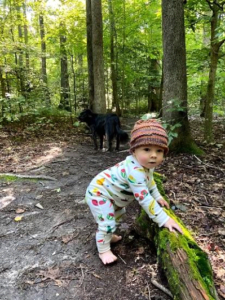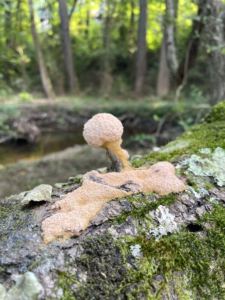
Have you ever heard of Forest Bathing? When I first heard people talking about this, I assumed it might have to do with taking a bath in the woods.
Back in 2019 I was at an arborist tree conference at Virginia Tech, where there was a presentation “Joy of Forest Bathing / Adaptation of Japanese Shinrin-Yoku by Melanie Choukas-Bradley”. Maybe 10 years earlier, I’m pretty sure I would have ignored this talk and gone to another class. But since I had been on a journey to improve my health, interested in foraging for wild foods, and questioning everything that I thought was normal, I knew I had to be at this talk with an open mind. The session was a guided outdoor walk, and I learned that Forest Bathing is basically encouragement to spend time outdoors – to sit or walk slowly, or even lie down, to see, smell, and touch the trees, forest, and soil around you. Melanie taught us a neat technique – by cupping our hands around our ears and putting our backs towards a creek or running water, the sounds are amplified into our ears. You hear sounds you otherwise would not notice!

So do you want to try Forest Bathing, but aren’t sure where to go? Ideally, pick a forest with little to no interference from external noises. Since most of you reading this may be in Richmond, you would have to drive a few hours out of town – and even then it will be hard to escape cars and other modern noises. I personally feel if I were to drive that far, I’d want to explore a good distance by hiking or biking. In all likelihood, you will be more willing to try this if it’s convenient.

Here are some suggestions on how to Forest Bathe in town:
- find a local patch of undisturbed woods or ground cover close to your house – this could be in your backyard
- ignore your phone – ensure it doesn’t make any noises and is out of sight
- go to a plant, tree, or patch of woods that seems interesting
- take off your shoes and feel the soil and leaves – try to imagine what is below the soil and what is living down there
- listen to the leaves moving in the wind or under your feet. Or simply watch them move even if they aren’t making any sounds
- listen to all the different sounds you can hear, like insects and birds
- touch the different barks on trees, touch the soil, rocks, sticks, or anything you can get your hands on
- smell the leaves, branches, bark, dead limbs, soil, or anything you can smell in the air
Here in Richmond, with all of the traffic and lawn machine noises, I try focusing on smells, sights, and touch, and turn off any other sounds that I can.
What is the goal while Forest Bathing?
- try to connect with the soil, plants, animals, insects, and environment individually, and also as a group
- have no agenda or expectations; just stop to see what happens

What are the benefits?
There are many that have been studied and published. Look this up and find there are an array of articles, books and podcasts on Forest Bathing.
- reduces stress and anxiety, strengthens immunity, lifts mood, improves sleep, improves blood pressure, and it’s meditative
- this might help adults and kids with Nature Deficit Disorder

Lastly, a piece of advice from Reilly Meng, whom I have had the good fortune of practicing yoga with weekly: “It’s very difficult for humans to engage in activities for the sake of the activity itself, without aiming at productivity, accomplishment or results. Like with any meditation, it isn’t until one abandons striving and looking for results that the benefits will occur.”


